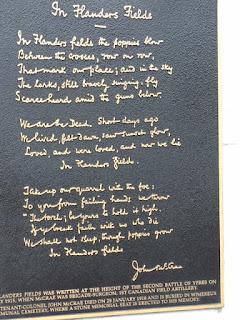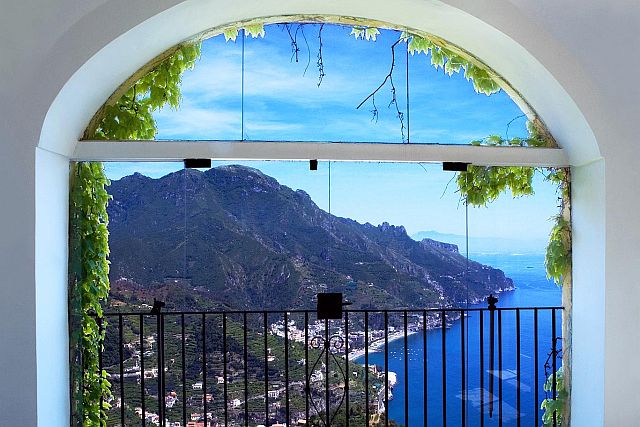 |
| John McCrae Memorial
"book" close-up. McCrae House,
(Creative Commons Attribution Share Alike 3.0 Unported License)
|
ESSEX FARM CEMETERY, YPRES,
BELGIUM — November
11, 2018 marked the 100th anniversary of the World War I armistice. In many
ways, the "Great War", as it is called, is also the "forgotten
war" because so few Americans know much about it.
In fact,
as of this writing, there is no memorial in our nation's capital that honors those
who perished in the preservation of our
liberty and freedom during World War I.
 |
| Muddy trenches were home for four long years (Courtesy: Imperial War Museum) |
In the countries and battlefields where the mayhem took place however, the story is quite different.
In early
May of 1915, Canadian military doctor and artillery commander Major John McCrae
composed his now famous poem In Flanders Fields in tribute to his close friend Lieutenant
Alexis Helmer who was killed on May 2, 1915 in the gun positions near Ypres . Helmer was just 22 years old.
In the
absence of the chaplain who had been called away, McCrae was asked to conduct
the burial of his friend.
It was a
Sunday morning when Helmer left his dugout taking a direct hit from an 8-inch
German shell. He was killed instantly. According to reports "what body
parts could be found were later gathered into sandbags and laid in an army
blanket for burial that evening."
 |
| Death march (Courtesy: Imperial War Museum) |
The
memorial ceremony was simple and brief as Major McCrae recited from memory a
few passages from the Church of England's Order of Burial of the Dead. Helmer's
burial site was marked by a simple wooden cross; a grave that has since been
lost.
 |
| Essex Farm Cemetery is home to the John McCrae Memorial (Courtesy: Commonwealth War Graves Commission) |
Today,
the John McCrae Memorial Site is a prominent feature of Essex Farm Cemetery
Established
next to a dressing station by the Canadian Field Artillery during the Second
Battle of Ypres, the cemetery is called "Essex Farm" to commemorate
the Essex Regiment. Many believe the name was chosen in honor of a member of
that regiment who was buried there in June 1915.
 |
| Model of battlefield and bunkers in Flanders (Courtesy: In Flanders Fields Museum) |
Following
Helmer's burial, it is believed that McCrae began to draft his poem, though
there are several accounts of what happened.
One
version says McCrae was seen writing the poem the next day, sitting on the rear
step of an ambulance while looking at Helmer's grave with the vivid red poppies
that were springing up amongst the graves in the burial ground.
Another
said that McCrae was so upset after Helmer's burial that he wrote the poem in
twenty minutes in an attempt to compose himself.
A third
version by commanding officer, Lieutenant Colonel Morrison, stated that John drafted
the poem partly to pass the time between the arrival of two groups of wounded soldiers
at the first aid post and partly to experiment with different variations of the
poem's meter.
 |
| Trenches, Ypres Salient (Photo: Taylor) |
Regardless
of which story is true, Major McCrae's poem is a haunting reminder of the
insanity of war. During the 16 day of the Second Battle of Ypres , of
which there were a total of five, one observer wrote this account:
"We saw how they crept out to
bury their dead during lulls in the fighting. So the rows of crosses increased
day after day, until in no time at all it had become quite a sizeable cemetery.
Just as John described it, it was not uncommon early in the morning to hear the
larks singing in the brief silences between the bursts of the shells and the
returning salvos of our own nearby guns.”
In the
autumn of 1914 a small burial ground had been established by the French Army on
a canal bank during the First Battle of Ypres. By May of the following year,
the site contained graves of both French and Canadian casualties becoming known
as Essex Farm British
Military Cemetery
It was
during the battle to defend Allied terrain in the northern Ypres Salient, that the
Germans introduced a deadly, never before used weapon, poison gas.
 |
| Plaque denotes the first use of poison gas in warfare (Photo: Taylor) |
Major
McCrae submitted his poem to The Spectator magazine but it was rejected and
returned. It was not published until Punch printed it on December 8, 1915.
In the Punch
version the word "blow" is used in the first line even though McCrae
also wrote the word "grow" in other handwritten rewrites. The poem contains
just 15 lines but they are as powerful and poignant as they are haunting:
 |
| Poppy fields of Flanders have become the symbol of the region and the war (Photo: Taylor) |
 |
| John McRae's poem (Photo: SherylForbis) |
"In
Between the crosses, row on row,
That mark our place; and in the sky
The larks, still bravely singing, fly
Scarce heard amid the guns below.
We are the Dead. Short days ago
That mark our place; and in the sky
The larks, still bravely singing, fly
Scarce heard amid the guns below.
We are the Dead. Short days ago
We lived, felt dawn, saw sunset glow,
Loved and were loved, and now we lie
In Flanders fields.
Take up our quarrel with the foe:
To you from failing hands we throw
The torch; be yours to hold it high.
If ye break faith with us who die
We shall not sleep, though poppies grow
In Flanders fields."
Travelers
who visit the Menin Gate Memorial and/or participate in the Last Post ceremony
will find Lieutenant Alex Helmer's name commemorated on Panel 10. His name is
among nearly 55,000 soldiers with no known grave in the battlefields of the
Ypres Salient.
 |
| Last Post at Menin Gate in Ypres honors the fallen every night of the year (Courtesy: VisitFlanders.com) |
Today,
in tribute to those fallen warriors, Ypres
honors them with a nightly ceremony known as the "Last Call." A
tradition which has been observed each evening since 1929.

















































